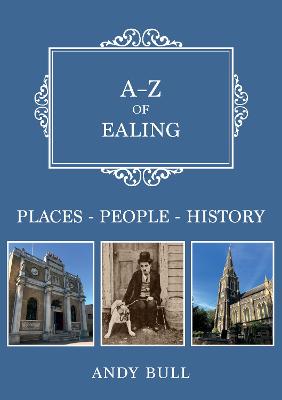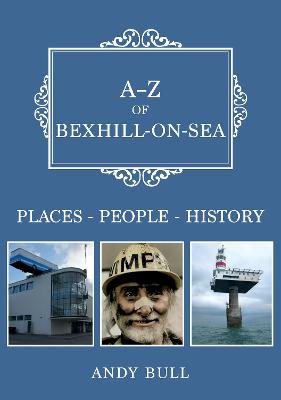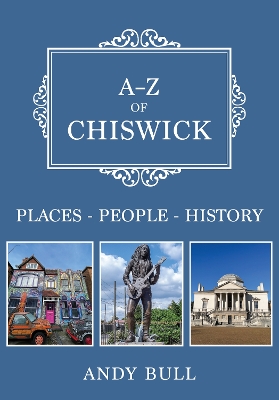A-Z
5 total works
Ealing is best known as the ‘Queen of the Suburbs’, but there is far more to its rich history than that. In the Middle Ages Ealing’s market gardens supplied much of London’s produce, and in later centuries it has played an often colourful part in history, being home to the royal mistresses of Edward III, George IV and Queen Victoria’s father, the Duke of Kent; and of Spencer Perceval, the only British prime minister to be assassinated.
A–Z of Ealing reveals the history behind Ealing, its streets and buildings, industries and the people connected with the borough. Alongside the famous historical connections are unusual characters, tucked-away places and unique events that are less well-known. Readers will discover tales of the notorious highwayman Sixteen String Jack, Ealing’s connection with the British music scene in the 1960s and Acton’s history as a spa resort, among many other fascinating facts in this A–Z tour of Ealing’s history. It is fully illustrated and will appeal to all those with an interest in this historic part of West London.
A–Z of Ealing reveals the history behind Ealing, its streets and buildings, industries and the people connected with the borough. Alongside the famous historical connections are unusual characters, tucked-away places and unique events that are less well-known. Readers will discover tales of the notorious highwayman Sixteen String Jack, Ealing’s connection with the British music scene in the 1960s and Acton’s history as a spa resort, among many other fascinating facts in this A–Z tour of Ealing’s history. It is fully illustrated and will appeal to all those with an interest in this historic part of West London.
Bexhill may have one of the highest percentages of retired people in the country, but this fascinating town does not deserve its reputation as God’s waiting room. The town was developed by the 7th Earl of Sackville as a seaside resort in the late nineteenth century and gained a reputation for health and longevity, as well as becoming home to around 300 independent schools before the outbreak of the Second World War. It has always been a pioneering place: the birthplace of British motor racing, the first resort to allow mixed bathing, the town where colour television was invented, and the venue for Bob Marley’s first gig in the UK. A wonderful array of fascinating characters, and a fair few true eccentrics, have called Bexhill home, including pioneering motorcycling rector Canon Basil Davies, and a hoax inventor of a death ray. The town has been immortalised in a Goon Show sketch by Spike Milligan, who trained with the army there in the Second World War, and celebrated by native Eddie Izzard, who put a replica of the coach from The Italian Job on the roof of the town’s art gallery.
A–Z of Bexhill-on-Sea reveals the history behind Bexhill, its streets and buildings and the people connected with the town. Alongside the famous historical connections are unusual characters, tucked-away places and unique events that are less well-known. Readers will discover tales of smuggling, the town’s link to Agatha Christie and its connection with the US state of Delaware among many other fascinating facts in this A–Z tour of Bexhill’s history. Fully illustrated, this book will appeal to all those with an interest in this historic East Sussex seaside town.
A–Z of Bexhill-on-Sea reveals the history behind Bexhill, its streets and buildings and the people connected with the town. Alongside the famous historical connections are unusual characters, tucked-away places and unique events that are less well-known. Readers will discover tales of smuggling, the town’s link to Agatha Christie and its connection with the US state of Delaware among many other fascinating facts in this A–Z tour of Bexhill’s history. Fully illustrated, this book will appeal to all those with an interest in this historic East Sussex seaside town.
Chiswick grew from a village on a bend of the River Thames to a fashionable retreat from London in the 18th century, then a suburb of London in the 19th century. The Palladian villa Chiswick House, with its landscaped gardens, was created by Lord Burlington in 1720 and artists and writers were drawn to the area, which also later became home to the Royal Horticultural Society and the first Garden Suburb at Bedford Park. Industries later associated with Chiswick included Thorneycroft marine builders and Fuller’s famous brewery. During the Second World War the first V-2 rocket to hit London fell on Staveley Road in Chiswick.
In A-Z of Chiswick Andy Bull reveals the history behind Chiswick, its streets and buildings, industries and the people connected with the town. Alongside the famous historical connections, are included some unusual characters, tucked away places and unique events that are less well-known. Readers will discover tales of glamorous residents of Chiswick House and rare plants grown in its glass-houses, the early days of the Arts and Crafts movement, writers, artists and actors among many other fascinating facts in this A-Z tour of Chiswick’s history. It is fully illustrated with photography and will appeal to all those with an interest in this historic West London town.
In A-Z of Chiswick Andy Bull reveals the history behind Chiswick, its streets and buildings, industries and the people connected with the town. Alongside the famous historical connections, are included some unusual characters, tucked away places and unique events that are less well-known. Readers will discover tales of glamorous residents of Chiswick House and rare plants grown in its glass-houses, the early days of the Arts and Crafts movement, writers, artists and actors among many other fascinating facts in this A-Z tour of Chiswick’s history. It is fully illustrated with photography and will appeal to all those with an interest in this historic West London town.
For centuries, Whitechapel has been at the centre of multicultural Britain. It has offered sanctuary to successive waves of immigrants fleeing religious intolerance, pogroms and poverty: Huguenots from France, Irish, Jews from Eastern Europe and Bangladeshis, each overlaying their own vibrant culture on the area. Whitechapel has been associated with notorious crimes in the past, not least Jack the Ripper, nineteenth-century body snatchers, the Kray twins and other gangsters. Social reformers such as George Peabody and William Booth, who founded the Salvation Army in Whitechapel, have left their legacy on the area.
In A–Z of Whitechapel author Andy Bull reveals the history behind the area’s streets, buildings, industries and the people connected with this part of East London. Alongside the famous historical connections, he includes some unusual characters, tucked-away places and unique events that are less well known. Readers will discover tales of Elizabethan theatres and Victorian freak shows, artists and writers, Whitechapel’s connection with Joseph Stalin and the area’s brewing and bell-founding heritage, among many other fascinating facts in this A–Z tour of Whitechapel’s history. Fully illustrated throughout, this book will appeal to all those with an interest in this historic East London district.
In A–Z of Whitechapel author Andy Bull reveals the history behind the area’s streets, buildings, industries and the people connected with this part of East London. Alongside the famous historical connections, he includes some unusual characters, tucked-away places and unique events that are less well known. Readers will discover tales of Elizabethan theatres and Victorian freak shows, artists and writers, Whitechapel’s connection with Joseph Stalin and the area’s brewing and bell-founding heritage, among many other fascinating facts in this A–Z tour of Whitechapel’s history. Fully illustrated throughout, this book will appeal to all those with an interest in this historic East London district.
Kew and Brentford are not so much separated by the River Thames as connected through it. The ford here was the first point on the tidal stretch of the great river that could easily be crossed on foot – meant many travellers have passed through down the centuries, perhaps the most famous being Julius Caesar. Kew has strong royal links and in 1759 Princess Augusta founded Kew Gardens, now known officially as the Royal Botanical Gardens. Today Kew is also famous for the National Archives. Kew and Brentford also have a rich industrial history, from pharmaceutical giants Beechams (and today GlaxoSmithKline) to aircraft manufacturers Sopwith and Handley Page and motor vehicle manufacturers Dodge and Chrysler.
In A-Z of Kew and Brentford Andy Bull reveals the history behind these towns, their streets and buildings, industries and the people connected with them. Alongside the famous historical connections, are included some unusual characters, tucked away places and unique events that are less well-known. Readers will discover tales of painters drawn to this area, the manufacture of Brompton folding bicycles in a railway arch and a notorious Victorian murderer among many other fascinating facts in this A-Z tour of Kew and Brentford’s history. It is fully illustrated with photography and will appeal to all those with an interest in these historic West London towns.
In A-Z of Kew and Brentford Andy Bull reveals the history behind these towns, their streets and buildings, industries and the people connected with them. Alongside the famous historical connections, are included some unusual characters, tucked away places and unique events that are less well-known. Readers will discover tales of painters drawn to this area, the manufacture of Brompton folding bicycles in a railway arch and a notorious Victorian murderer among many other fascinating facts in this A-Z tour of Kew and Brentford’s history. It is fully illustrated with photography and will appeal to all those with an interest in these historic West London towns.




